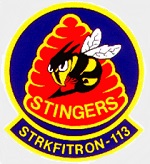Hobby Master HA3540 US Navy Boeing F/A-18C Hornet Strike Fighter - VFA-113 "Stingers," USS John C. Stennis (CVN-74), 2005 (1:72 Scale)
"Bigger, Higher, Faster, Farther."
- Thinking within the US Air Force during the late 1970s
 The F/A-18 Hornet is the true multi-role aircraft. It can vault from a carrier deck, bomb a target and stay to dogfight even the best enemy aircraft without missing a beat. It's the Navy's first modern-era jet intended for double duty against air- and ground-based adversaries. Armed to the hilt with Sparrow and Sidewinder air-to-air missiles, an internal cannon, and laser-guided bombs, this modern warbird was an outstanding performer in Operation Desert Storm. Strapped into a digital cockpit described as a cross between Star Wars and a video game, pilots of the F/A-18 Hornet take on the ultimate aviation job: blasting this single-seat, high-performance jet off the deck of a carrier, dropping bombs, and firing air-to-ground ordnance. Offering unmatched agility, the Hornet is the choice aircraft of the US Navy's elite Blue Angels aerobatic team.
The F/A-18 Hornet is the true multi-role aircraft. It can vault from a carrier deck, bomb a target and stay to dogfight even the best enemy aircraft without missing a beat. It's the Navy's first modern-era jet intended for double duty against air- and ground-based adversaries. Armed to the hilt with Sparrow and Sidewinder air-to-air missiles, an internal cannon, and laser-guided bombs, this modern warbird was an outstanding performer in Operation Desert Storm. Strapped into a digital cockpit described as a cross between Star Wars and a video game, pilots of the F/A-18 Hornet take on the ultimate aviation job: blasting this single-seat, high-performance jet off the deck of a carrier, dropping bombs, and firing air-to-ground ordnance. Offering unmatched agility, the Hornet is the choice aircraft of the US Navy's elite Blue Angels aerobatic team.
The F/A-18C is the single-seat variant and the F/A-18D is the two-seat variant. The D-model can be configured for training or as an all-weather strike craft. The "missionized" D model's rear seat is configured for a Marine Corps Naval Flight Officer who functions as a Weapons and Sensors Officer to assist in operating the weapons systems. The F/A-18D is primarily operated by the U.S. Marine Corps in the night attack and Forward Air Controller (Airborne) (FAC(A)) roles.
The F/A-18C and D models are the result of a block upgrade in 1987 incorporating upgraded radar, avionics, and the capacity to carry new missiles such as the AIM-120 AMRAAM air-to-air missile and AGM-65 Maverick and AGM-84 Harpoon air-to-surface missiles. Other upgrades include the Martin-Baker NACES (Navy Aircrew Common ejection seat), and a self-protection jammer. A synthetic aperture ground mapping radar enables the pilot to locate targets in poor visibility conditions. C and D models delivered since 1989 also have improved night attack abilities, consisting of the Hughes AN/AAR-50 thermal navigation pod, the Loral AN/AAS-38 NITE Hawk FLIR (forward looking infrared array) targeting pod, night vision goggles, and two full-color (formerly monochrome) multi-function display (MFDs) and a color moving map.
Pictured here is a gorgeous 1:72 scale diecast replica of a US Navy F/A-18C Hornet Strike Fighter that was attached to VFA-113 "Stingers," that was embarked upon the USS John C. Stennis (CVN-74) during 2005.
Sold Out!
Dimensions:
Wingspan: 7-1/2-inches
Length: 9-inches
Release Date: October 2018
 Historical Account: "Stingers" - Strike Fighter Squadron 113 (VFA-113), also known as the Stingers, is a United States Navy strike fighter squadron based at Naval Air Station Lemoore, California. They are an operational fleet F/A-18E Super Hornet squadron attached to Carrier Air Wing 17 (CVW-17) and based at NAS Lemoore, California. Their tailcode is NA and their radio callsign is Sting.
Historical Account: "Stingers" - Strike Fighter Squadron 113 (VFA-113), also known as the Stingers, is a United States Navy strike fighter squadron based at Naval Air Station Lemoore, California. They are an operational fleet F/A-18E Super Hornet squadron attached to Carrier Air Wing 17 (CVW-17) and based at NAS Lemoore, California. Their tailcode is NA and their radio callsign is Sting.
The squadron, along with the rest of CVW-14, took part in the USS Ronald Reagan's maiden deployment from January through July 2006. The deployment took the squadron through the Western Pacific and into the Persian Gulf in support of Operation Iraqi Freedom.









